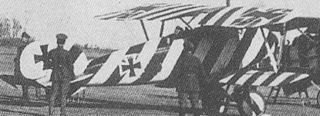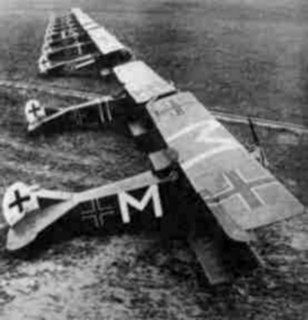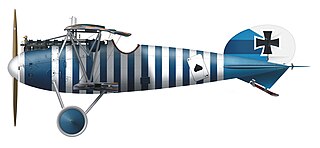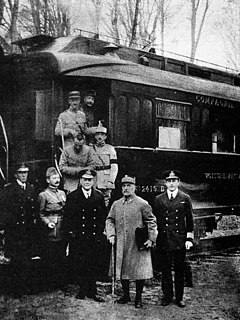Leutnant Otto Creutzmann was a World War I flying ace credited with eight aerial victories.

Royal Prussian Jagdstaffel 39, commonly abbreviated to Jasta 39, was a "hunting group" of the Luftstreitkräfte, the air arm of the Imperial German Army during World War I. The unit would score 68 aerial victories during the war, including 14 observation balloons downed. The squadron's victories came at the expense of seven pilots killed in action, one killed in a flying accident, five wounded in action, and one taken prisoner of war.
Royal Prussian Jagdstaffel 43, commonly abbreviated to Jasta 43, was a "hunting group" of the Luftstreitkräfte, the air arm of the Imperial German Army during World War I. The unit would score over 35 aerial victories during the war, including two observation balloons downed. The squadron's victories came at the expense of six killed in action, five wounded in action, two injured in accidents, and one taken prisoner of war.
Royal Württemberg Jagdstaffel 47, commonly abbreviated to Jasta 47 or Jasta 47W, was a "hunting group" of the Luftstreitkräfte, the air arm of the Imperial German Army during World War I. Incomplete records credit the squadron with 14 aerial victories during the war. The unit's known casualties include three killed in action, one injured in a flying accident, three wounded in action, and one taken prisoner of war.
Royal Saxon Jagdstaffel 54, commonly abbreviated to Jasta 54, was a "hunting group" of the Luftstreitkräfte, the air arm of the Imperial German Army during World War I. The squadron would score over 20 aerial victories during the war, including four observation balloons downed. The unit's victories came at the expense of three pilots killed, and one injured in a flying accidents.

Royal Prussian Jagdstaffel 59, commonly abbreviated to Jasta 59, was a "hunting group" of the Luftstreitkräfte, the air arm of the Imperial German Army during World War I. The squadron would score over 20 aerial victories during the war. The unit's victories came at the expense of four pilots killed in action and two wounded in action.
Royal Prussian Jagdstaffel 70, commonly abbreviated to Jasta 70, was a "hunting group" of the Luftstreitkräfte, the air arm of the Imperial German Army during World War I. The squadron would score over 14 aerial victories during the war. The unit's victories came at the expense of two killed in action and three wounded in action.
Royal Prussian Jagdstaffel 71, commonly abbreviated to Jasta 71, was a "hunting group" of the Luftstreitkräfte, the air arm of the Imperial German Army during World War I. The squadron would score eight aerial victories during the war, including three observation balloons downed. The unit's victories came at the expense of four killed in action and one wounded in action.

Royal Saxon Jagdstaffel 72, commonly abbreviated to Jasta 72, was a "hunting group" of the Luftstreitkräfte, the air arm of the Imperial German Army during World War I. The squadron would score over 58 aerial victories during the war, including three observation balloons downed. The unit's victories came at the expense of two killed in action, one wounded in action, and one taken prisoner of war.
Royal Prussian Jagdstaffel 73, commonly abbreviated to Jasta 73, was a "hunting group" of the Luftstreitkräfte, the air arm of the Imperial German Army during World War I. squadron would score 29 aerial victories during the war, including seven night victories, and including an observation balloon downed. The unit's victories came at the expense of three killed in action.
Royal Bavarian Jagdstaffel 76, commonly abbreviated to Jasta 76, was a "hunting group" of the Luftstreitkräfte, the air arm of the Imperial German Army during World War I. The squadron would score over 20 aerial victories during the war. The unit's victories came at the expense of six killed in action, four wounded in action, and three taken prisoner of war.

Royal Bavarian Jagdstaffel 79, commonly abbreviated to Jasta 79, was a "hunting group" of the Luftstreitkräfte, the air arm of the Imperial German Army during World War I. The squadron would score over 28 aerial victories during the war, including three observation balloons downed. The unit's victories came at the expense of four killed in action, three killed in flying accidents, 13 wounded in action, two injured in aviation accidents, and three taken prisoner of war.
Royal Bavarian Jagdstaffel 80, commonly abbreviated to Jasta 80, was a "hunting group" of the Luftstreitkräfte, the air arm of the Imperial German Army during World War I. The squadron scored 15 aerial victories during the war, including four observation balloons downed. The unit's victories came at the expense of two killed in action, three killed in flying accidents, two injured in accidents, six wounded in action, and one taken prisoner of war.
Royal Prussian Jagdstaffel 85, commonly abbreviated to Jasta 85, was a "hunting group" of the Luftstreitkräfte, the air arm of the Imperial German Army during World War I.
Royal Prussian Jagdstaffel 86, commonly abbreviated to Jasta 86, was a "hunting group" of the Luftstreitkräfte, the air arm of the Imperial German Army during World War I.
Royal Prussian Jagdstaffel 87, commonly abbreviated to Jasta 87, was a "hunting group" of the Luftstreitkräfte, the air arm of the Imperial German Army during World War I.
Royal Prussian Jagdstaffel 88, commonly abbreviated to Jasta 88, was a "hunting group" of the Luftstreitkräfte, the air arm of the Imperial German Army during World War I.
Royal Prussian Jagdstaffel 89, commonly abbreviated to Jasta 89, was a "hunting group" of the Luftstreitkräfte, the air arm of the Imperial German Army during World War I.
Royal Prussian Jagdstaffel 90, commonly abbreviated to Jasta 90, was a "hunting group" of the Luftstreitkräfte, the air arm of the Imperial German Army during World War I.
Royal Württemberg Jagdstaffel 84, commonly abbreviated to Jasta 84, was a "hunting group" of the Luftstreitkräfte, the air arm of the Imperial German Army during World War I.







